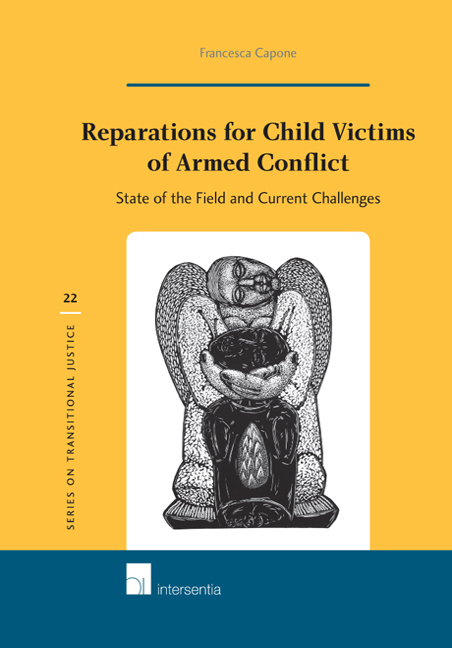Book contents
- Frontmatter
- Dedication
- Foreword
- About the Author
- Acknowledgements
- Contents
- Table of Cases
- Table of International Instruments
- List of Abbreviations
- Chapter 1 Setting the Scene
- PART I THE NORMATIVE AND THEORETICAL FRAMEWORK
- Chapter 2 Children as Victims of Armed Conflict
- Chapter 3 The Right to Reparation in International Law: Developments, Shortcomings and their Relevance to Child Victims of Armed Conflict.
- Chapter 4 Forms and Scope of Reparations for Child Victims of Armed Conflict
- PART II CURRENT APPLICATION OF THE PRINCIPLES AND NORMS
- Bibliography
- Index
Chapter 3 - The Right to Reparation in International Law: Developments, Shortcomings and their Relevance to Child Victims of Armed Conflict.
from PART I - THE NORMATIVE AND THEORETICAL FRAMEWORK
Published online by Cambridge University Press: 29 September 2018
- Frontmatter
- Dedication
- Foreword
- About the Author
- Acknowledgements
- Contents
- Table of Cases
- Table of International Instruments
- List of Abbreviations
- Chapter 1 Setting the Scene
- PART I THE NORMATIVE AND THEORETICAL FRAMEWORK
- Chapter 2 Children as Victims of Armed Conflict
- Chapter 3 The Right to Reparation in International Law: Developments, Shortcomings and their Relevance to Child Victims of Armed Conflict.
- Chapter 4 Forms and Scope of Reparations for Child Victims of Armed Conflict
- PART II CURRENT APPLICATION OF THE PRINCIPLES AND NORMS
- Bibliography
- Index
Summary
INTRODUCTION
The key principles that traditionally govern the right to reparation are spelled out in the judgment of the case concerning the Factory at Chorz o w, issued by the Permanent Court of International Justice (‘ PCIJ’) in 1928. According to the Court:
It is a principle of international law that the breach of an engagement involves a [State's] obligation to make reparation in an adequate form [and] reparation must, as far as possible, wipe out all the consequences of the illegal act and re-establish the situation which would, in all probability, have existed if that act had not been committed.
On that occasion the PCIJ clearly described the common approach to reparations in an inter-State dispute. Such approach has been reiterated several times and has been enshrined in the International Law Commission (‘ ILC’) Articles on Responsibility of States for Internationally Wrongful Acts (‘ Articles on State Responsibility’). These Articles explain that a State responsible for the commission of a wrongful act is under an obligation to cease the conduct and to offer appropriate assurances, normally given verbally, and guarantees of non-repetition, such as preventive measures to be taken to avoid repetition of the breach. The responsible State is also under an obligation to make reparation for the injury caused by the internationally wrongful act. The forms of reparations, identified in the Articles on State Responsibility and endorsed by the jurisprudence of the ICJ and its predecessor are restitution, compensation and satisfaction, either singly or in combination and, where appropriate, accompanied by interest. The evolution of the right to reparation, marked, inter alia, by the adoption of the Basic Principles and Guidelines, has led to the identification of other forms of reparation, including rehabilitation and guarantees of non-repetition. Unlike the Articles on State Responsibility, the UNBPG focuses on the right to reparation for victims (not States), meaning individuals or collectives who have suffered harm including physical or mental injury, emotional suffering, economic loss or substantial impairment of their fundamental rights, through acts or omissions that constitute violations of international law. Until quite recently, the existence of an individual's right to reparation was questioned, mainly due to the limited practice supporting the concrete exercise of this right.
- Type
- Chapter
- Information
- Reparations for Child Victims of Armed ConflictState of the Field and Current Challenges, pp. 69 - 110Publisher: IntersentiaPrint publication year: 2017



